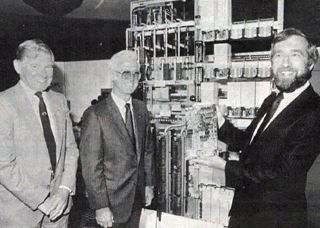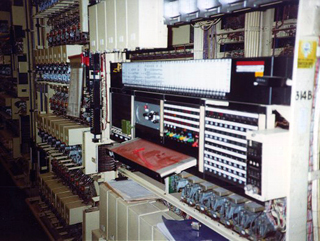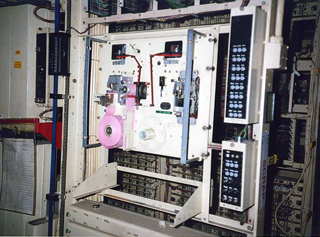...connecting the UK
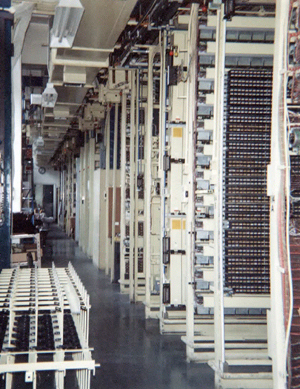 |
|
In the UK, the very first Strowger exchange opened at Epsom in Surrey in 1912 and coincided with the Post Office taking overall responsibility for the whole network # which had previously been owned by a number of private telephone companies. It was not until 23 June 1995 that the very last Strowger exchange on the BT PSTN (Public Switched Telephone Network) at Crawford in Scotland, was finally taken out of service as the digital age became a reality. There are still a few working Strowger exchanges outside of the BT network, but these are quickly disappearing as they become too labour intensive to maintain and are unable to give the flexibility that solid-state equipment with software programming can offer.
# Hull Corporation [Kingston Comms, laterly KCOM Group] are still responsible for their own part of the Network. However, in 2009, KCOM outsourced the management of its own network to BT Wholesale, which also gave it access to BT's national network.
Almon B. Strowger
TXS or Strowger exchanges, were electro-mechanical and known as step-by-step, as the switching stages follow a pre-wired start to finish path through the equipment. Throughout the Strowger era there have predominantly been only three different versions of the 2- motion selector, some older exchanges using a mixture of all three, which were :
|
Generally, the sizes of Strowger exchanges were given by their function, thus a Main exchange would be larger than a Satellite and a Group Switching Centre larger than both.
MNDX the first Mobile Non-Director eXchange, Crompton, was brought into use in February 1963 as relief to Shaw auto exchange in Lancashire.
MTXs Mobile Tandem eXchanges to off-load junction traffic were developed at the same time.
2000-type Selectors
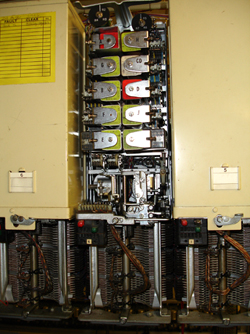 |
Strowger switches were alive and trained maintenance staff could diagnose a faulty switch simply by listening to the sound of the relays operating and the movement of the vertical and horizontal stepping... |
In smaller towns and more remote sites where a full size exchange was neither justified or necessary, Unit Automatic eXchanges (UAXs) were installed. Often the equipment was housed in sealed units (suitable for use in unheated buildings) and a complete exchange would be made up of several units, hence the name.
UAX1-UAX4 early pre-2000 types.
UAX5 100 line capacity, including junctions. MDF not enclosed. The last UAX5 in the UK, on the Isle of Coll was converted to a SAX. during November 1974.
UAX6 200 line capacity.
UAX7 the AGS system designed by ATE (Automatic Telephone & Electric Co.), GEC (General Electric Co.) and Siemens Brothers. Originally used sealed units in unheated buildings, but later versions used open racks in heated buildings. 800 line capacity.
UAX8 used 100 outlet pre-200 type final selectors and 50-point linefinder/ uniselectors.
UAX9 (Bypath type S) used 50-point Bypath switches designed by Standard Telephone & Cables.
UAX10 (Bypath type QC) 200 line capacity.
UAX11 (Bypath type R) 80 line capacity.
UAX12 first standardized version of UAXs with pre-2000 type equipment, originally designed for up to 100 lines. Replaced UAXs 5 & UAXs 11.
MAX12 mobile version of above.
UAX13 2000 type, designed to cater for 200-400 lines, but often extended to 800.
MAX13 mobile version of above.
UAX13(R) replacement of the subscriber units of UAX12s to extend their life.
UAX14 2000 type, superseded UAX7s & UAX9s, used open type racks in heated buildings and could originally cater for up to 800 lines.
In some areas however, rather than use UAX equipment, it was more economical to install minor Non-Director exchanges, which were known as Small Automatic eXchanges (SAXs).
The first SAX was opened at Bury in West Sussex in 1964.
Even smaller Country Satellite eXchanges (CSXs), for between 10 and 20 subscribers, could be provided from equipment housed in a metal box fitted to a pole. CSXs, however were connected directly to the manual board and were superseded for automatic working by the Line Connector (LC).
All logos and trade marks are the property of their respective owners and are used on the Light Straw site(s) for review only. Students and researchers are recommended to make their own independent enquiries as to the accuracy of the information contained therein.
